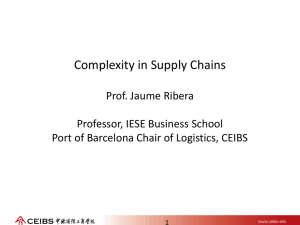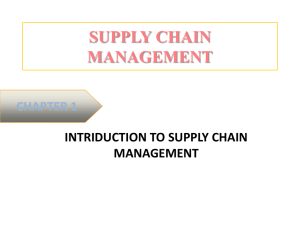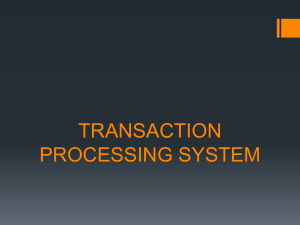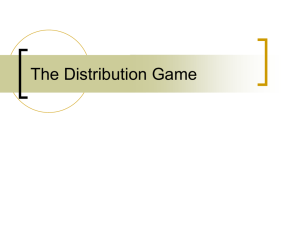Customer complexity
advertisement
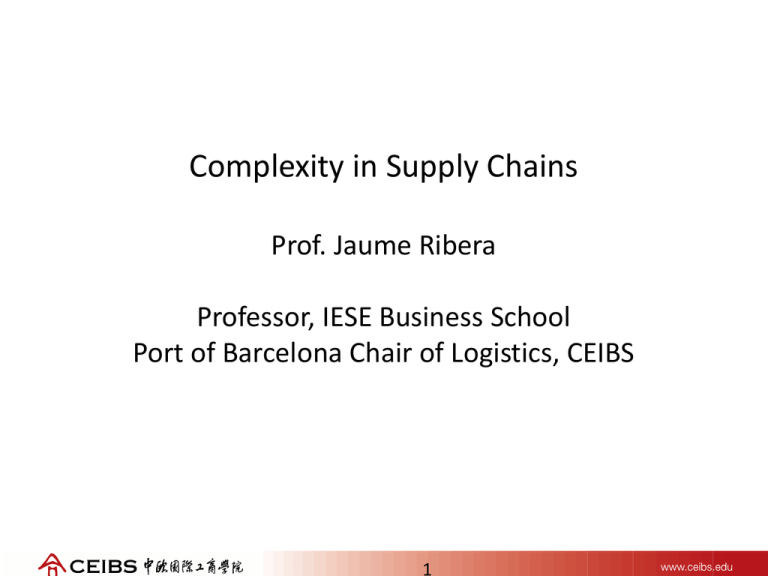
Complexity in Supply Chains Prof. Jaume Ribera Professor, IESE Business School Port of Barcelona Chair of Logistics, CEIBS 1 Supply Chain Complexity "If you are in Supply Chain Management today, then complexity is a cancer you have to fight. Process management is the weapon. Understand that Supply Chain Management is too important to be simply a function. It is everybody's job.“ Tom Blackstock, Vice President Supply Chain Operations Coca-Cola North America 2 3 Performance measurement - The SCOR Model (Level 1) • Supply Chain Reliability – – – – • On time delivery Order fulfillment lead time Fill rate Perfect Order Fulfillment Percentage Days Percentage Percentage Flexibility and Responsiveness – Supply Chain Response Time – Upside production flexibility • Days Days Expenses – Supply Chain Management Costs – Warranty Cost / Revenue – Value added per employee • Percentage Percentage Euros/RMB Assets / utilization – Total inventory days of supply – Cash-to-Cash Cycle time – Net Asset turns Days Days Turns 4 Complexity • Complexity is simply destroying the profitability at many companies, and executives often can’t see what the true cause is. • More suppliers, more parts, more forecasting, more customers to ship to, more returns to manage, etc. Our accounting systems lack the ability to well capture the true cost of this complexity, keeping it hidden. • • One major reason for increasing complexity is that companies do not do a realistic cost/benefit analysis on adding complexity. “Complexity Factor” (CF) index. CF = # of suppliers * # of customers * # of employees * # of SKUs * # of markets * # of SC locations * # of countries /total company revenue 5 Elements of complexity • • • • • • • • • Network complexity (nodes, links, tiers, distance, potential for unexpected disruptions, …) Process complexity (process steps, ownership, darwinian evolution, …) Variety complexity (natural tendency to grow, impact on forecasting accuracy, …) Product complexity (number of products, components, interactions, novelty, technology, no commonality in BOM, …) Customer complexity (customization demands, ordering patterns, frequency, size, delivery requirements, …) Supplier complexity (number of relationships, level of cooperative work, …) Organizational complexity (silo organizations, not sharing info, tendency to create intricacy, …) Information complexity (tendency to opacity, systems not talking to each other, info filtering, …) …. 6 Characteristics of complexity Numerousness Variability Variety Diversity Interdependency Uncertainty Filiz Isik, Complexity in Supply Chains 7 Drivers of Supply Chain Complexity Configuration and Structure • Number of suppliers • Number of manufacturing locations • Number of distribution channels • Number of distribution centers • Number of ship-to locations • Number of customers Products and Services • Number of products/services • Number of direct materials • Number of shipments • Number of orders Processes and Systems • Supply chain processes and practices • Supply chain organization • Manufacturing strategy • Number of legacy information systems Deriving Benefit From Supply Chain Complexity, Vickers & Kodarin, 2006 8 Steps in Complexity management 9 Impact of complexity reduction Effectiveness (customer related performance) Complexity reduction levers Complexity management levers Efficiency (cost related performance) 10 An example of complexity: bullwhip 11 Understanding bullwhip: the beer game Retailer Wholesaler Send order day D Distributor Factory Order received day D+1 Supplier Customer Available day D+3 Shipment day D+1 12 Orders 70 60 50 40 Retailer Wholesaler Distributor 30 Factory Demand 20 10 0 0 5 10 15 20 25 -10 13 30 35 40 How to make the best decision 1.- Surprise demand !! Period D-2 D-1 D Initial Inventory 8 8 8 Receptions 4 4 4 Available Inventory 12 12 12 Demand 4 4 5 Shipment 4 4 5 Final Inventory 8 8 7 Order 4 4 14 D+1 D+2 D+3 How to make the best decision 2.- Forecast future periods (no forecasting error) Period D-2 D-1 D Initial Inventory 8 8 8 Receptions 4 4 4 Available Inventory 12 12 12 Demand 4 4 5 Shipment 4 4 5 Final Inventory 8 8 7 Order 4 4 15 D+1 D+2 D+3 5 5 5 How to make the best decision 3.- Fill expected evolution Period D-2 D-1 D D+1 D+2 D+3 Initial Inventory 8 8 8 7 6 5 Receptions 4 4 4 4 4 Available Inventory 12 12 12 11 10 Demand 4 4 5 5 5 Shipment 4 4 5 5 5 Final Inventory 8 8 7 6 5 Order 4 4 16 5 How to make the best decision 4.- Determine desired final safety inventory Period D-2 D-1 D D+1 D+2 D+3 Initial Inventory 8 8 8 7 6 5 Receptions 4 4 4 4 4 Available Inventory 12 12 12 11 10 Demand 4 4 5 5 5 Shipment 4 4 5 5 5 Final Inventory 8 8 7 6 5 Order 4 4 17 5 10 How to make the best decision 5.- Complete the table and determine order now Period D-2 D-1 D D+1 D+2 D+3 Initial Inventory 8 8 8 7 6 5 Receptions 4 4 4 4 4 10 Available Inventory 12 12 12 11 10 15 Demand 4 4 5 5 5 5 Shipment 4 4 5 5 5 5 Final Inventory 8 8 7 6 5 10 Order 4 4 10 So, the retailer gets a demand of 4, 4, 4, 5 and passes orders for 4, 4, 4, 10. What will happen to the wholesaler? 18 Computer modeling Exponential smoothing fi fi 1 ( xi 1 fi 1 ) xi 1 (1 ) fi 1 with = 0.25 Forecast Real 4.00 4 4.00 4 19 4.00 4 4.00 5 4.25 ?? = 0.25 Orders 35 30 Complexity behaviour 25 Customer Retailer Wholesaler Distributor Factory Quantity 20 15 10 5 0 0 5 10 15 20 25 Periods 20 30 35 40 The Barilla case Final customer pasta consumption 21 Barilla - JITD 22 Conclusions • Competition occurs at the level of supply chains • Complexity is increasing in supply chains • There are many types of complexity. They all factor into an overall system complexity • There are two approaches to deal with complexity: – Reduce complexity – Learn to how to handle it • To improve it, there are some intermediate working stages Improve Manage Analyze Measure Describe Observe 23 Control
